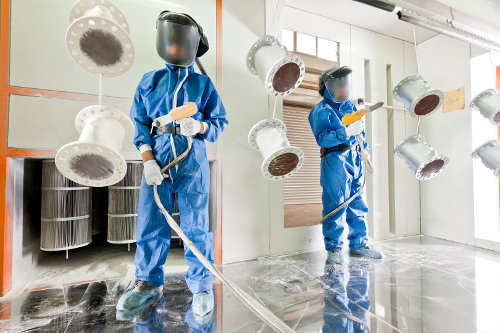If you are tasked with powder coating a surface by a client, you will probably do well to accept that no matter how diligent you are with your application process, there are regularly going to be some imperfections and defects that need further work.

Using someone like Reliant Finishing Systems for equipment and training services will help to ensure that you are ready for the job in hand, and can help to reduce the number of surface defects that need correcting.
Preventing a defective substrate
One of your primary objectives is to try and implement a series of process controls which are upstream of the coating line, in order to eliminate or reduce the prospect of a defective substrate from entering the line.
If you discover that a substrate is defective, the best course of action is normally to work on trying to recognize the source of the blemish rather than waste time and resources attempting to fix the coating process, simply to correct what turns out to be a pre-existing substrate condition.
There is no question that the issue of dirt particles on the surface of a coated part is a source of concern and frustration for coaters of all abilities and experience.
Airborne contamination
One of the major problems you are likely to encounter when it comes to the whole powder coating process, is airborne contamination. Compared to curing metal coating using industrial ovens like those provided by pqovens.com, powder coating requires extra effort in preventing airborne contamination. This is something that is need to be considered upon when choosing powder coating over other types of coating.
The fundamental issue with airborne contamination is quite simply that there are numerous common sources that could contribute to or be the main source of the problem.
If you are looking for the primary culprit, you could easily point to work personnel. It is estimated that maybe as at least 75% of airborne contamination can be traced back to the clothing, hair or footwear of the person working in the immediate working environment.
It is also sometimes difficult to keep the effect of nature itself away from the workplace. This means that dust and pollen can enter the building via any entry and exit points, as well as through any unfiltered air supply systems.
Even concrete floors can produce a certain amount of dust as they wear away, so you have to be extremely vigilant and proactive about trying to reduce the prospect of airborne contamination from a wide variety of sources.
Pay attention to the pretreatment process
It would be a fair observation to say that the quality of the powder coating finish that you achieve, will be heavily influenced by how good your pretreatment process is.
One of your main priorities should be to clean using a combination of a spray washer and an alkaline cleaner. This should be effective in helping to remove any dirt, soils or even rust inhibitors, that may have found their way onto the substrate.
You experience difficulties in successfully removing some things like rust, mill scale or even mildew, using just a spray washer. If that proves to be the case, you might want to consider using a suitable chemical treatment or alternatively, it might need to be removed by blasting or grinding the surface.
One thing is for sure, if the substrate has not be cleaned to a high standard, there is every chance that the powder coating you are applying, may simply refuse to adhere to the surface, causing the powder to flake or peel shortly afterwards.
Humidity control
You may already well be aware that powder is particularly sensitive to the effects of excess moisture in the environment.
If you do not control the humidity levels successfully, you may well experience a situation where the powder starts to gather together in clumps.
Excessive humidity will likely result in compromising the consistency and fluidity of of the spray. When this happens, you will normally notice that balls of powder form, clogging up the pump and other equipment, if the situation is not rectified.
Your aim should be to store the powder at a regulated temperature of between 72F and 75F, and achieve a relative humidity ration of about 55%.
Create a controlled environment
There are many external influences and scenarios that could so easily compromise the powder itself or your ability to use spray equipment at maximum efficiency.
One of the most efficient ways of minimizing these issues is to create a controlled environment.
A purpose-built environmental room will allow you the opportunity to reduce and even potentially eliminate any defects, allowing you to achieve a perfect powder coating finish each and every time.
Preventing powder coating defects is preferable to repairing them if you can, so work on ways to achieve this aim.
About the Author: Zak Payne is a quality inspector for a manufacturing company. Outside of work he has a geek side, enjoying tabletop games, along with blogging and caring for his pet lizard.


